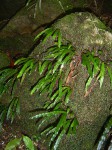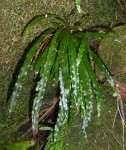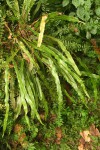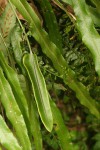Elaphoglossum aubertii (Desv.) T. Moore
Synonyms |
Acrostichum aubertii Desv. |
|---|---|
Common name |
|
Description |
Rhizome short creeping to suberect, 3-8 mm in diameter; rhizome scales brown, lanceolate to linear in outline, entire, pointed, 3-5 mm long, phyllopodia absent. Fronds tufted, thinly herbaceous, erect or arching, simple, strongly dimorphous. Sterile fronds: 18-45 cm long, stipe up to 14 cm long, straminous to pale brown, with persistent twisted squarose scales, c. 2 mm long; lamina 16-40 × 1.1-2.5 cm, linear or very narrowly elliptic in outline, apex tapering to a point, base gradually tapering and then broadly wedge-shaped to the stipe, margins entire or slightly wavy with sparse brown scales, margins also with a continuous row of small dot-like hydathodes situated c. 1 mm from the margin; midrib with scales similar to those of the stipe; veins evident, c. 2 mm apart, at 45-50° angle to the costa. Fertile fronds: stipe mostly double but up to five times as long as the stipes of the sterile fronds; lamina 3-10 × 1.2-2 cm, resembling a spearhead, apex rounded to pointed, base square or truncate, intersporangial scales lacking, lamina entirely covered by sporangia on the underside. |
Notes | Can be confused with E. hybridum; this species however has a continuous hair-like fringe of dark scales along the margin, the row of hydathodes is absent. |
Derivation | aubertii: this fern was first collected on Réunion by a French naturalist called Aubert du Petit-Thouars (1758-1831) |
Habitat | It grows on mossy boulders or on wet rock in deep shade in evergreen forest at high altitudes and in bamboo zone. |
Distribution worldwide | Africa, Madagascar, Comoro Isl., Réunion, São Tomé, Mauritius. |
Distribution in Africa |
Cameroon, Congo, Dem. Republic of Congo, Equatorial Guinea (incl. Bioko), Ethiopia, Kenya, Liberia, Malawi, Mozambique, Rwanda, South Africa, Tanzania , Uganda, Zimbabwe. |
Growth form |
Epiphytic, lithophytic, terrestrial. |
Literature |
|



